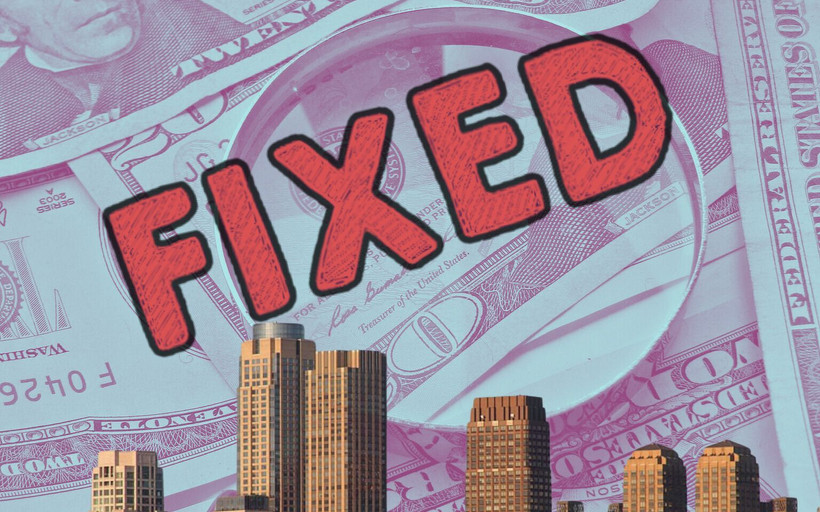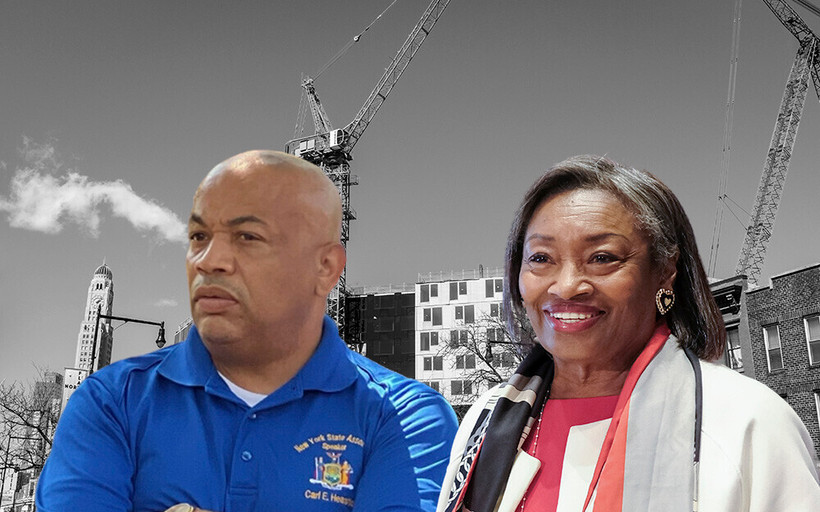Will Eric Adams Let Landlords Buy Their Way Out Of Energy Upgrades?
Recent transmission projects could enable building owners to get out of upgrading their buildings for a decade, if Adams doesn’t intervene.

In 2019, New York City passed a landmark climate law, hailed as the most ambitious to be enacted by any U.S. city. Its centerpiece took aim at buildings, the city’s biggest source of carbon emissions, by requiring owners to implement upgrades and meet progressively tighter emissions caps over the coming decades. Analysts estimated it could create tens of thousands of jobs, cut local pollution, and ultimately reduce the city’s carbon emissions by 80 percent.
But building owners may have a way out.
The law doesn’t require them to meet its targets through energy efficiency upgrades alone. It also allows them to buy a potentially unlimited number of “renewable energy credits” (RECs), which enable buyers to reduce their carbon footprint by investing in green energy.
That leaves a crucial decision in Mayor Eric Adams’ hands: will his administration cap how many RECs building owners can use to comply? His administration will face that question, among others, in a council oversight hearing on Monday centering on the law’s impact on jobs. If Adams chooses not to cap REC use, experts say, the credits could effectively allow landlords to buy their way out of upgrading New York City buildings.
That prospect became much more real in April, when New York’s Public Service Commission issued its final approval of two major clean energy projects, set to deliver some 18 million megawatt-hours of electricity to the city per year, or roughly a third of what it currently consumes. Each of those megawatt-hours will also generate one REC, creating a flood of credits—enough to theoretically allow every building owner who wanted to to get by for at least a decade without making almost any upgrades on site.
To avoid such a scenario, advocates want Adams to impose strict limits on how many RECs building owners can use to comply with the law, capping them at 10 percent of a building’s total allowed emissions.
This is just one of the critical issues Mayor Adams and his aides must rule on this year. The city has until the beginning of 2023 to issue a wide range of guidelines determining how strict Local Law 97 will ultimately be for building owners, in what many see as the biggest test of Adams’s climate policy.
‘Be careful what you wish for’
Early signs from Mayor Eric Adams and his aides sparked fears among Local Law 97’s backers that he might seek to water it down, making concessions to real-estate interests who have been among his top campaign donors—and Local Law 97’s most vocal critics. Recent statements from Chief Climate Officer Rohit Aggarwala and other administration figures have tempered some of those concerns, but key questions remain.
RECS are a critical factor in that debate. Advocates who campaigned for the law say the inclusion of RECs reflects a twofold goal: not only to reduce fossil fuel in buildings themselves—through energy efficiency upgrades and electrification of heating and cooking—but also to clean up the city’s electric grid, which relies overwhelmingly on fossil fuels. Three years later, they can point to tangible progress on this second goal, with major offshore wind and other renewable energy projects scheduled to come online in the second half of the 2020s.
The Public Service Commission’s recent approval of two major transmission projects—including the hotly debated Champlain Hudson Power Express (CHPE), which will bring Canadian hydropower to the five boroughs—marks arguably the biggest step so far in getting New York City off fossil fuels. Three of the body’s seven commissioners cited Local Law 97 as a factor in their vote to approve the two projects, on the grounds that RECs bought by building owners could help offset the costs of the multibillion-dollar power line for everyday ratepayers.
Daniel Zarrilli, former chief climate policy advisor to Mayor Bill de Blasio, said the New York City law brought real estate, other business interests, the building trades, and planning groups behind renewable energy development in a way they hadn’t previously been.
“The way that Local Law 97 built a larger constituency for the Tier 4 clean energy transmission projects, I think was an absolute bonus that helped get those important projects done,” Zarrilli said.
But climate organizers worry that a flood of RECs from CHPE and Clean Path, approved in tandem, could amount to too much of a good thing.
“Local Law 97 has already had a giant success in propelling the state to improve both transmission into the city and renewable energy development,” said Pete Sikora, climate and inequality campaigns director at the progressive advocacy group New York Communities for Change. “But that’s a ‘be careful what you wish for’ kind of situation…. We want to make sure that the practical energy efficiency improvements in buildings are also done and don’t get left behind.”
If building owners were to meet the law’s mandates through retrofits alone, Urban Green Council estimates that it could create more than 140,000 jobs in the NYC metro area by 2030. But all of those jobs reflect a complicated and above all expensive process for building owners, who have been lobbying the city and state hard to give them cheaper ways to comply. The RECs promised by CHPE and Clean Path offer a golden opportunity.
Altogether, the two projects are expected to put some 18 million RECs on the market by 2027. New York City has committed to buying 20 percent of those (between 3 and 4 million) to power city government, leaving a projected 14-15 million available for other buyers, according to the state energy agency NYSERDA. Up to 7 million of those could come from CHPE alone, beginning as soon as 2025—a year after Local Law 97’s first emissions caps take effect.
An analysis commissioned by the Real Estate Board of New York (REBNY) estimatedthat building owners could use RECs to meet up to 85 percent of the emissions reductions required under the law until 2034.
Byron Stigge, director of Level Infrastructure, which conducted the study, said the heavy skew toward RECs reflects a simple calculus for building owners. For most buildings expected to exceed the 2030 emissions caps, the fines would amount to roughly $1 per square foot. Buying RECs involves a little more effort, but would likely be cheaper. And both of those options would be considerably cheaper—at least in the short term—than upgrading their buildings.
You’ve got your hard-earned money going right out those drafty windows.
Relatively simple, low-cost energy efficiency measures like replacing lightbulbs and fixing leaks start in the range of $5 per square foot and typically shave off a small fraction of a building’s energy use, Stigge said. Many building owners are already moving forward with those kinds of upgrades. But for a deeper retrofit—replacing windows and heating systems throughout an apartment complex, for example—just the first step of hiring an expert to assess what is needed can cost more than the annual Local Law 97 fines.
A retrofit is “kind of like open heart surgery,” Stigge said, and most residential landlords are not ready for the “cost and pain and complexity.”
Given those hurdles, Stigge sees RECs as a necessary tool in the broader push to decarbonize, buying building owners time for the massive effort of going fully carbon-free.
In that time, they could scoop up anywhere from 5-13 million RECs—a level of demand that CHPE and Clean Path would likely satisfy.
The total RECs from the two projects would dwarf the number expected from a previous REBNY-backed proposal to water down Local Law 97 by expanding access to RECs. The proposal, inserted in last year’s state budget by then-governor Andrew Cuomo, was strongly opposed by climate groups and ultimately defeated in the legislature. (RECs allowed under the proposal would have funded existing clean energy across the state, overriding the law’s requirement that RECs go strictly toward new renewables delivered into New York City.)
CHPE and Clean Path could be even more consequential, allowing landlords to avoid major retrofits well into the 2030s. The REBNY-commissioned study projected that only 5 to 10 percent of required emissions reductions for the 2030–2034 period would come from energy efficiency upgrades.
‘The work needs to be done’
Climate organizers want to see that scenario flipped. Sikora says they had hoped to see a cap on RECs written into the law from day one, but lost that battle to real estate. Now, they are pushing the Adams administration to make good on that ambition through rulemaking, not only capping REC use at 10 percent but also ensuring the credits only count against emissions from a building’s electricity use—not from fossil-fueled appliances on site, such as boilers.
“RECs are only relevant to electricity supply. So to have an electricity REC being used to offset gas consumption, that is not apples to apples,” said Jasmine Graham, energy justice policy manager at WE ACT for Environmental Justice.
The push to limit RECs has support on the New York City Council, where Sanitation Committee chair and former climate organizer Sandy Nurse is among those opposing any measure that would allow landlords to “simply buy their way out” of upgrading their buildings.
“It is important that the City limit the number of RECs available,” Nurse told New York Focus by email. “We don’t need more carbon credits or offsets, we need the buildings to be retrofitted—the work needs to be done.”
But, as Local Law 97 is written, the decision rests with the city’s executive agencies, not the council. When Nurse raised the issue at a council oversight hearing on the law last month, Chief Climate Officer Aggarwala said that the city was still drafting its guidelines but that it aimed “not to allow RECs to be used overly broadly.”
The Department of Environmental Protection did not provide more specifics when reached for comment.
Real estate groups have long sought flexibility in meeting Local Law 97 targets. “Local Law 97 does not limit the extent to which a building owner can use eligible renewable energy credits to comply with its emissions limit,” said Alexander Shapanka, assistant vice president of policy at REBNY, in a statement. “We look forward to continued discussions with all stakeholders about how to help building owners comply with this law and invest in the green economy rather than pay fines to the City’s general fund.”
Some analysts point out that the lift required of building owners already looks much smaller than it did when Local Law 97 passed in April 2019. That’s in large part because, a few months later, the state passed its own landmark climate law, requiring New York to entirely decarbonize its electric grid by 2040. If the grid decarbonizes at that pace, research suggests the owners of half of the city’s major real estate won’t have to do anything at all—even buy RECs—to follow Local Law 97 for the next decade or so.
For climate advocates, that’s just one more reason for the city to limit REC use and ensure that landlords still have enough of an incentive to upgrade their buildings.
“New York has the oldest building stock in the country,” said Graham, of WE ACT. “Our buildings are so massively inefficient. There are so many jobs to be created in New York City, and everywhere…. That’s one of the beautiful things about buildings—that they are everywhere, and so they can create jobs everywhere.”
Beyond jobs, upgrading New York City buildings could also reduce the burden of pollution on working-class communities of color, who disproportionately live in buildings with outdated heating systems relying on dirty energy like fuel oil. And it could help rein in spiking energy bills, which are already higher—and rising faster—in New York than in all but a handful of other states.
“When you put it together with the fact that these BIPOC and low-income communities live in old, inefficient housing, you’ve got your hard-earned money going right out those drafty windows,” Graham said.
The city’s recently passed budget offers a sign that the Adams administration is willing to at least compromise with advocates, adding five staff at the Department of Buildings office tasked with overseeing Local Law 97 implementation. (Advocates say the office needs at least ten more staff; Adams’ preliminary budget had added none.)
Questions also remain around the extent that the city will enforce fines that climate organizers and Aggarwala alike have described as giving the law teeth—fines that now also face a court challenge from three building owners.
Despite the growing pains, even some Local Law 97 skeptics say it has pushed the real estate sector toward decarbonization in an unprecedented way.
“I’ve been in the business for 25 years now, and it really feels like a sea change after Local Law 97 was passed,” Stigge said. “It’s got people talking more, and more seriously, than ever. So that’s a good thing.”



